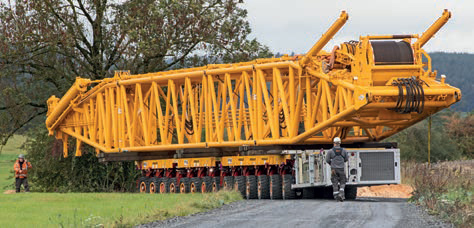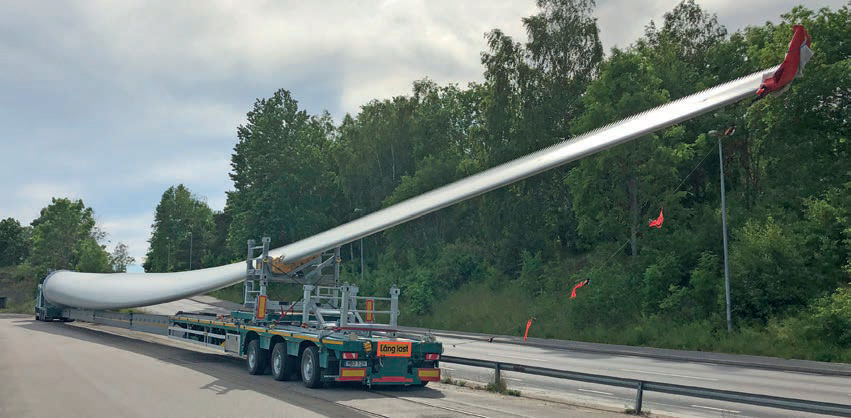Keeping things moving
12 February 2021Despite the Covid-19 pandemic, Faymonville Group has introduced a number of products to the market over the past year. Sotiris Kanaris talks to product manager Rainer Noe and sales director Arnold Luxen.
Faymonville Group consists of three vehicle brands—Faymonville, Cometto and MAX Trailer— and offers solutions for the transportation of payloads of 15t to more than 15,000t.
In its portfolio there are low loaders, lowbed trailers, flatbed trailers, self-steering trailers, inloaders, modular vehicles and self-propelled modular transporters. The challenging economic environment of the past year, has not deterred the Group from launching a number of new products.
The most recent launch was of the Faymonville ModulMax twin-tyre range, including the new self-propelled version with electronic steering. “We always aim to develop new features to fill out the last puzzles within the product range. And with this new development foreseen for the modular trailer world, we complete the offer within this heavy-duty field. Customers have now the choice between different steering systems—mechanical and electronical—and different modes (trailer mode, self-propelled mode and assist mode) for the heaviest challenges in special transport,” says product manager Rainer Noe.
The electronic steering system is utilising technology of Cometto, a brand that the group acquired in 2017. Cometto power pack units are also offered for the ModulMax range.
Commenting on the cooperation between the Group’s two brands, sales director Arnold Luxen says: “Cometto has been the specialist for self-propelled technology for a long time, so it was obvious to include its proven technology in the further development of the ModulMax range. Working hand in hand, in product development as well as in the production cycle, is one of our key strengths.”
Cometto also expanded its portfolio in the past year, with the addition of the Eco1000 self-propelled electronically steered modular vehicle with integrated Power Pack Unit (PPU) for jobs up to a payload of 1,000t.
Luxen says the integrated PPU is very beneficial to users, as it allows them to have a longer loading platform. Customers are able to choose from three power pack technologies: traditional propulsion technology, hybrid or electric solution. “The hybrid choice is unique within the market of special transport vehicles. The whole concept builds on a future oriented modular principle and offers an easy connect and drive configuration.”
The Eco1000 is available with two, four and six axle lines; and can be used for a wide range of applications, including crane transportation. “Cometto’s Eco1000 and self-propelled electronically steered modular vehicles from the MSPE range are ideally suited for off-road transports,” says Luxen.
The Faymonville brand also offers transport solutions for the crane sector. “The Faymonville MultiMAX low loader is the economic and flexible answer to many challenges in the crane segment.” The MegaMax low bed semi-trailers with removable gooseneck can transport cranes in all weight categories, according to the manufacturer.
Noe adds: “The specialist for transporting crane components and crane weights is the Faymonville CargoMax flatbed trailer. The reinforced chassis on the compact platform trailer ensures robustness in a highly demanding area. The Faymonville CombiMax and Faymonville ModulMax series of modular vehicles, in their technical composition, bring together many features for challenges in the crane sector.”
Wind Energy
Another sector the company gains a lot of business from is the wind energy sector. Last June, the company expanded its offering to this sector with the introduction of the new WingMax generation, part of the TeleMax flatbed semi-trailer series.
“For wind turbine blades in XXL format with a length of more than 70m, Faymonville has developed a vehicle that is not only long, but also strong and very easy to manoeuvre. The unique selling point of the new flatbed trailer is the interaction of several technical advantages: enormous gooseneck stroke, longest available loading platform with four-fold extension, gooseneck length compatible with five-axle trucks and strong 19.5in pendle-axles for a steering angle of up to 60° and a maximum stroke of 600mm.”
Faymonville has also developed further its FlexMax self-steering trailer technology. “With this rotor blade transport system, customers can realise wind blade transports for elements up to 100m,” says Luxen.
He adds that the WingMax has proven very popular. “The market was really demanding this flatbed and we have already delivered many units to customers in Sweden, Italy, Turkey, Spain and South America.”
Luxen has also seen high demand for the BladeMax, the blade lifter with capacity of 650mT, and the new Max510 lowbed vehicle by MAX Trailer with pendle-axles, which was launched last year. Faymonville’s low bed range MegaMax, VarioMax and GigaMax are used to transport heavier wind turbine components.
Global and Local
“Our customers are active in many sectors and we provide our special vehicles to all five continents,” says Luxen.
As the equipment requirements can differ from country to country, Faymonville has also designed products tailored to local markets. For example there is a large number of products offered exclusively to the North American market; one of them is HighwayMax.
The original HighwayMax was a nine-axle highway trailer with a legal payload of more than 170,000lbs and a technical payload of more than 250,000lbs.
Faymonville then launched the HighwayMax-Booster. “It’s a 12-axle highway trailer pushing the legal payload towards 205,000lbs, with a technical payload without booster up to 275,000lbs. The three-axle booster give the possibility to increase the payload capacity. It is very easy to connect and to remove,” says Noe.
The wheel bogies of the HighwayMax-Booster have been reinforced in order to allow the lifting of the booster under full payload. Closed and with the booster decked, the truck and trailer length remains below 90ft, allowing to travel without escort in most states. The vehicle has hydraulically steered pendle-axles with a stroke of 24in and a steering angle of 60°.
“And with the HighwayMax- Booster&Dolly, the third generation joins the product family. The HighwayMax-Booster&Dolly is an extendable super heavy haul trailer composed of nine hydraulically steered pendle-axles, a three-axle jeep dolly and a three-axle booster. Including the truck, this unit creates a 19-axle combination and achieves a legal payload of about 245,000lbs at 20,000lbs per axle.”
Talking about the company’s plans for future portfolio expansion, Noe says: “We are always working on new product developments. In this way, we were able to become a full-range supplier and in this way we will extend this state also in the future.
Our philosophy is to go ahead and to work out the transport market’s requests into reality. And these developments go into the smallest details.”
 Cometto MSPE self-propelled vehicles were used to relocate a Liebherr LR 11000 crawler crane belonging to Wiesbauer within the Rugendorf wind farm in Upper Franconia, Germany. Wiesbauer used its Cometto MSPE self-propelled vehicles with 14- axle combination to transport the 42m long derrick mast weighing 60t. (Image credit: Jürgen Stresius)
Cometto MSPE self-propelled vehicles were used to relocate a Liebherr LR 11000 crawler crane belonging to Wiesbauer within the Rugendorf wind farm in Upper Franconia, Germany. Wiesbauer used its Cometto MSPE self-propelled vehicles with 14- axle combination to transport the 42m long derrick mast weighing 60t. (Image credit: Jürgen Stresius)
